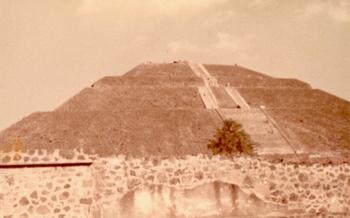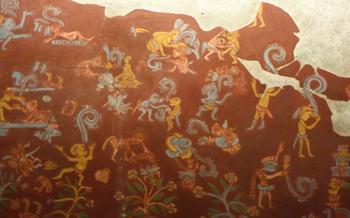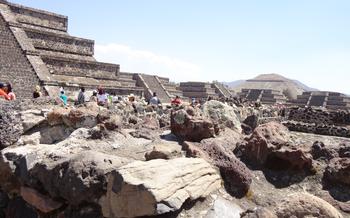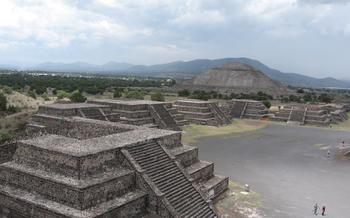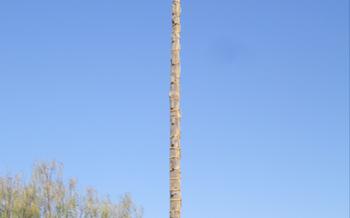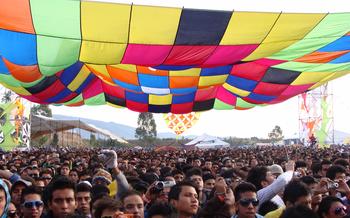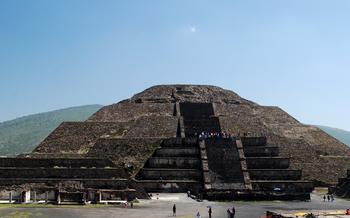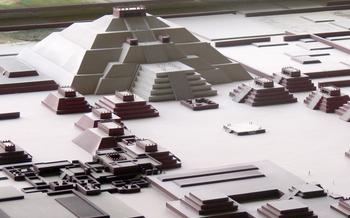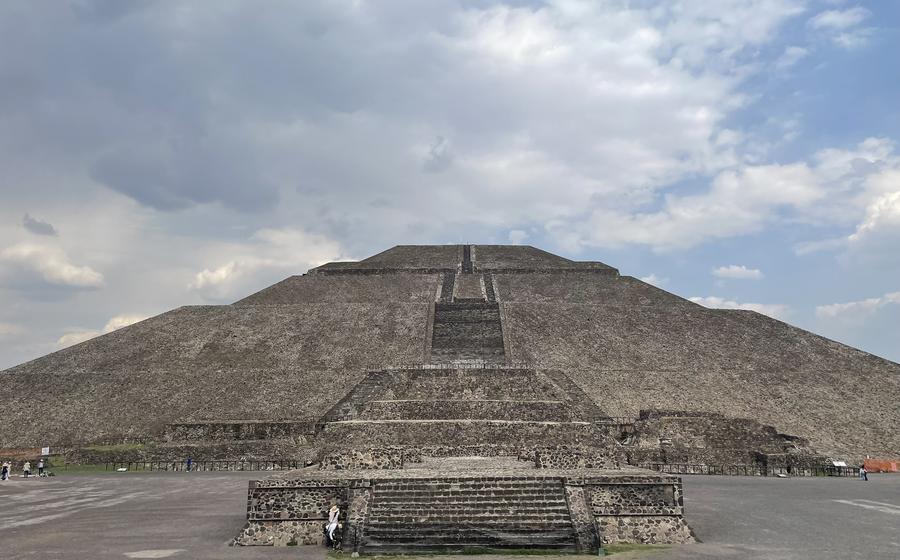
Pyramid of the Sun
- The Wonder of Teotihuacan
- Awe-Inspiring Pyramid of the Sun
- Exploring the Avenue of the Dead
- Unveiling the Mysteries of the Sun Pyramid
- Exploring the Tunnels
- The Temple of Quetzalcoatl
- Historical and Cultural Context
- Panoramic Views from the Pyramids
- Interactive Museums and Exhibitions
- The Avenue of the Dead at Night
- Sustainable Tourism Practices
- Exploring Surrounding Areas
- Planning Your Visit
- Insider Tip: Unveiling Hidden Gems and Local Delights
The Wonder of Teotihuacan
Teotihuacan, a sprawling metropolis in Pre-Columbian Mesoamerica, beckons travelers with its allure of ancient wonders and historical significance. Recognized by UNESCO as a World Heritage Site, this city thrived between the 1st and 7th centuries AD, leaving behind awe-inspiring structures that stand as testaments to its ingenuity and grandeur. As one of Mexico's most popular tourist destinations, Teotihuacan draws visitors from around the world, eager to explore its secrets and marvel at its architectural marvels. Join us as we delve into the wonders of this ancient city, unravelling its mysteries and discovering its enduring legacy.
Awe-Inspiring Pyramid of the Sun
At the heart of Teotihuacan lies the awe-inspiring Pyramid of the Sun, the largest structure in the ancient city. Towering over the Avenue of the Dead at a height of 75 meters, this colossal pyramid is a testament to the ingenuity and architectural prowess of the Teotihuacanos. Constructed using adobe bricks and faced with stone, the pyramid's impressive dimensions and precise alignments with the cosmos continue to captivate visitors to this day.
The pyramid's construction involved a sophisticated understanding of engineering and astronomy. Aligned with the cardinal points, the pyramid's orientation allowed the Teotihuacanos to track the movements of the sun and stars, using the pyramid as a giant calendar and observatory. The pyramid's four sides are further divided into terraces, creating a stepped appearance that adds to its grandeur.
The symbolic and religious significance of the Pyramid of the Sun cannot be overstated. Believed to represent the sacred mountain of creation, the pyramid served as a place of worship and pilgrimage for the Teotihuacanos. The pyramid's summit was likely used for religious ceremonies and rituals, and its vast size and impressive height were meant to connect the earthly realm with the divine.
For visitors, climbing the Pyramid of the Sun is a must-do experience. The steep climb rewards with breathtaking panoramic views of the entire archaeological site, the surrounding valley, and the distant mountains. The climb also offers a unique perspective on the pyramid's massive scale and intricate construction. However, it is essential to note that climbing the pyramid requires a certain level of fitness and may not be suitable for everyone.
Exploring the Avenue of the Dead
The Avenue of the Dead, also known as the Miccaotli, is the central axis of Teotihuacan, connecting the Pyramid of the Moon to the Pyramid of the Sun. Stretching for over 2 kilometers, this grand boulevard was once the heart of the ancient city, lined with temples, palaces, and residential compounds.
As you stroll along the Avenue, marvel at the Pyramid of the Moon, the second-largest pyramid in Teotihuacan. Its imposing structure stands at the northern end of the avenue, inviting you to explore its mysteries.
Don't miss the Temple of Quetzalcoatl, located on the Avenue's western side. Dedicated to the Feathered Serpent God, this temple boasts intricate carvings and colorful murals that depict mythical creatures and scenes from Teotihuacan's history.
The Avenue of the Dead is not just about ancient ruins; it's also a vibrant hub of activity. Vendors selling traditional crafts, souvenirs, and refreshments line the streets, creating a lively atmosphere. You can also enjoy cultural performances, such as traditional dances and music, that bring the ancient city to life.
Unveiling the Mysteries of the Sun Pyramid
The Pyramid of the Sun in Teotihuacan is shrouded in an air of mystery, with numerous theories speculating on its construction and purpose. Archaeologists have conducted extensive excavations and ongoing research to unravel the secrets of this colossal structure.
One intriguing theory suggests that the pyramid was built as a massive calendar, with its alignment precisely corresponding to the movements of the sun and stars. According to this theory, the pyramid's orientation allowed the ancient Teotihuacanos to accurately predict solstices, equinoxes, and other celestial events, demonstrating their advanced understanding of astronomy.
Another theory posits that the pyramid served as a religious and ceremonial center. Its location at the heart of Teotihuacan and its impressive size suggest that it was a sacred space for rituals, offerings, and other religious practices. The discovery of numerous artifacts and offerings within the pyramid further supports this theory.
The Pyramid of the Sun's alignment with the cosmos is another remarkable feature. The pyramid's main axis is precisely aligned with the sunrise on the summer solstice, casting a striking shadow that perfectly bisects the structure. This alignment suggests that the pyramid may have been used for astronomical observations and ceremonies related to the sun's cycles.
The construction of the Pyramid of the Sun is also a testament to the ingenuity and engineering prowess of the Teotihuacanos. Built without the use of wheels, metal tools, or mortar, the pyramid stands as a marvel of ancient architecture. Its size and complexity demonstrate the advanced level of urban planning and construction techniques that existed in Pre-Columbian Mesoamerica.
Exploring the Tunnels
Venturing beneath the Pyramid of the Sun is a unique opportunity to delve into the enigmatic world of Teotihuacan. Guided tours lead visitors through a network of dark, narrow passageways, providing a glimpse into the hidden depths of this ancient structure. Along the way, discover fascinating artifacts and learn about the significance of these tunnels, which may have served as ceremonial chambers or burial sites. Safety measures are in place to ensure a safe and memorable exploration of this subterranean realm.
The Temple of Quetzalcoatl
The Temple of Quetzalcoatl, also known as the Temple of the Feathered Serpent, stands as a testament to the intricate artistry and religious beliefs of the Teotihuacanos. Dedicated to the revered deity Quetzalcoatl, the temple showcases unique architectural features and iconography that set it apart from other structures within the city. Its distinctive talud-tablero design, characterized by alternating slopes and vertical panels, creates a visually striking effect. The temple's facades are adorned with elaborate carvings and sculptures depicting Quetzalcoatl and other deities, providing glimpses into the mythology and religious practices of the Teotihuacan civilization. Ongoing restoration efforts aim to preserve this magnificent temple, ensuring its continued existence as a symbol of Teotihuacan's cultural heritage.
Historical and Cultural Context
Teotihuacan's history and cultural significance are deeply intertwined with the development of Mesoamerican civilization. Once a bustling metropolis, it served as a religious, political, and economic center for centuries. The city's unique architecture, art, and writing system reflected its advanced cultural achievements.
Teotihuacan's influence extended far beyond its borders, shaping the development of other Mesoamerican societies. Its cultural and religious practices were adopted and adapted by neighboring city-states, contributing to the cultural diversity and richness of the region.
Despite its eventual decline, Teotihuacan's legacy continues to inspire and intrigue scholars and visitors alike. Ongoing research and excavations are shedding new light on the city's origins, daily life, and the reasons for its eventual abandonment.
Preserving and protecting Teotihuacan's cultural heritage is of utmost importance. As a UNESCO World Heritage Site, it represents a tangible link to our past and a reminder of the ingenuity and creativity of ancient civilizations. By safeguarding this remarkable site, we can ensure that future generations can continue to appreciate and learn from its enduring legacy.
Panoramic Views from the Pyramids
As you ascend the ancient steps of the Pyramid of the Sun or the Pyramid of the Moon, you'll be rewarded with breathtaking vistas that stretch far beyond the archaeological site. From the summits of these colossal structures, you'll have a bird's-eye perspective of the entire Teotihuacan complex, with the Avenue of the Dead slicing through the heart of the city like a sacred artery. The vast expanse of the valley unfolds before you, dotted with smaller pyramids, temples, and residential compounds. The panoramic views from the pyramids offer a unique opportunity to appreciate the sheer scale and grandeur of this ancient metropolis.
Capture the moment with panoramic photographs that encompass the entire archaeological site, preserving these breathtaking vistas for posterity. Standing atop these ancient structures, you'll gain a profound sense of connection with the people who built and inhabited this extraordinary city. Safety precautions and guidelines are in place to ensure your well-being as you climb the pyramids, allowing you to fully immerse yourself in the awe-inspiring panorama that awaits you.
Interactive Museums and Exhibitions
Enrich your understanding of Teotihuacan's captivating history and culture by visiting the on-site museums. The Teotihuacan Museum, located near the entrance, houses a remarkable collection of artifacts, including pottery, sculptures, and murals, providing a glimpse into the daily lives and rituals of the ancient city's inhabitants.
At the Quetzalpapálotl Museum, situated close to the Temple of Quetzalcoatl, you can marvel at intricate displays showcasing the iconic Feathered Serpent deity, as well as other significant figures from Teotihuacan's pantheon. Interactive exhibits and models bring the ancient civilization to life, allowing you to delve deeper into their beliefs and practices.
Through these museums, you'll gain valuable insights into the sophisticated society that once thrived in Teotihuacan, enhancing your appreciation for the wonders of this ancient metropolis.
The Avenue of the Dead at Night
As darkness falls, the Avenue of the Dead transforms into a magical spectacle, offering a unique and unforgettable experience. Special events and night tours illuminate the pyramids, casting an ethereal glow over the ancient city. Visitors can stroll along the Avenue, admiring the illuminated structures and soaking in the mystical atmosphere. Cultural performances and light shows bring the ancient city to life, showcasing the rich history and traditions of Teotihuacan. With the stars above and the pyramids below, capturing stunning photographs of the illuminated archaeological site becomes a cherished memory.
Sustainable Tourism Practices
As you embark on your journey through Teotihuacan, remember that responsible tourism is essential for preserving this cultural gem. Here are some tips to minimize your environmental impact and respect the site's significance:
- Tread Lightly: Stick to designated paths and avoid climbing or damaging structures.
- Leave No Trace: Carry all your trash and recyclables with you.
- Respect Local Customs: Dress modestly and behave respectfully towards the local community.
- Support Local Businesses: Purchase souvenirs and handicrafts from local vendors to support the community's economy.
- Educate Yourself: Learn about Teotihuacan's history and culture to appreciate its significance.
- Spread Awareness: Share your experiences and encourage others to practice responsible tourism.
By following these guidelines, you can contribute to the preservation of Teotihuacan for future generations while ensuring a positive and enriching experience for all.
Exploring Surrounding Areas
Venturing beyond the archaeological site of Teotihuacan, visitors can discover a wealth of nearby attractions and towns that offer a glimpse into the region's rich history, culture, and traditions. A short distance away lies the charming town of San Juan Teotihuacan, home to a vibrant market where locals sell traditional crafts, colorful textiles, and souvenirs. Visitors can immerse themselves in the local culture by sampling regional delicacies at the market's food stalls or enjoying a leisurely meal at one of the town's many restaurants.
Another nearby town worth exploring is Otumba, renowned for its historical significance as the site of a decisive battle between the Spanish conquistadors and the Aztec Empire. History buffs can visit the Museo de la Batalla de Otumba to learn about this pivotal event and its impact on the course of Mexican history. Otumba is also known for its beautiful colonial architecture, with landmarks such as the Parroquia de Santiago Apóstol and the Ex-Convento de San Francisco attracting visitors from near and far.
Exploring the surrounding areas of Teotihuacan provides a well-rounded experience, allowing travelers to delve deeper into the region's cultural tapestry and gain a profound appreciation for its historical significance. Whether it's discovering local crafts, savoring authentic cuisine, or delving into the past, there's something for every traveler to enjoy beyond the iconic pyramids of Teotihuacan.
Planning Your Visit
Timing is Everything: The best time to visit Teotihuacan is during the shoulder seasons (April-May and September-October) when the weather is pleasant, and the crowds are smaller. Avoid visiting during the peak tourist season (December-March) unless you're prepared for large crowds and higher temperatures.
Dress for Success: Teotihuacan is a vast archaeological site, so comfortable clothing and footwear are essential. Opt for lightweight, breathable fabrics that won't restrict your movement. Wear sturdy shoes or hiking boots to navigate the uneven terrain and climb the pyramids.
Sun Protection: The Mexican sun can be intense, so protect yourself with sunscreen, sunglasses, and a hat. Stay hydrated by carrying a reusable water bottle, as there are limited water sources within the site.
Capture the Moment: Teotihuacan offers countless photo opportunities, so bring your camera or smartphone to capture the stunning vistas and ancient structures. Use a wide-angle lens to fit the massive pyramids and the Avenue of the Dead into your shots.
Insider Tip: Unveiling Hidden Gems and Local Delights
As you explore the wonders of Teotihuacan, don't miss the opportunity to venture off the beaten path and discover hidden gems that offer a unique perspective on this ancient city. One such spot is the Museo de la Pintura Mural Teotihuacana, located just a short walk from the Pyramid of the Sun. This museum houses a collection of beautifully preserved murals that provide a glimpse into the artistic and cultural traditions of the Teotihuacanos. Take your time to admire the intricate details and vibrant colors of these ancient masterpieces.
For an authentic culinary experience, head to the Mercado San Juan, a bustling market located in the heart of Teotihuacan. Here, you can savor the flavors of traditional Mexican cuisine, from mouthwatering tacos and enchiladas to fresh fruits and vegetables. Be sure to try the local specialty, nopales, or cactus paddles, which are often served grilled or in salads.
If you're seeking a deeper understanding of Teotihuacan's history and culture, consider booking a guided tour with a local expert. These tours often provide insights into the latest archaeological discoveries and theories, as well as the significance of the site's many monuments and artifacts.
To make the most of your visit, plan your trip around one of the many festivals or events that take place in Teotihuacan throughout the year. These celebrations offer a vibrant blend of traditional rituals, music, dance, and local cuisine, allowing you to experience the city's rich cultural heritage firsthand.

